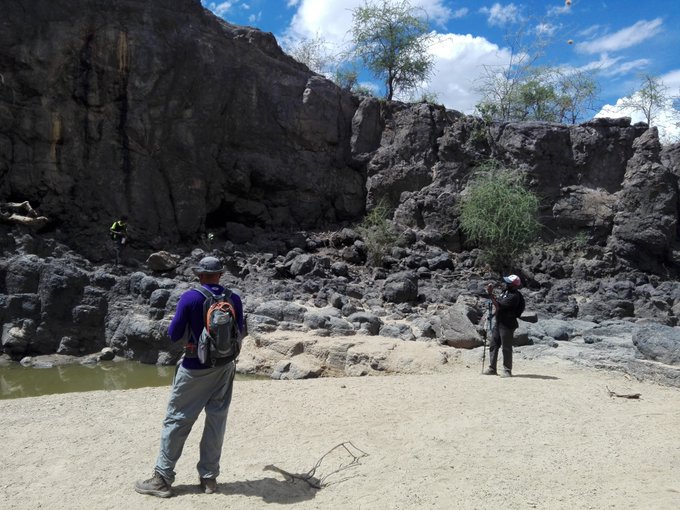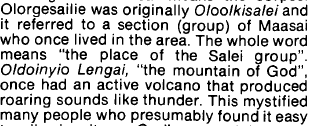One of my favourite places in the country lies towards the south, near the bottom of the Rift Valley: Olorgesailie. I love it for its wild, rugged landscapes with untouched nature. To imagine that the Maasai have lived and thrived here probably for centuries gives me a new found respect for these people. And so when I saw that Let’s Drift had introduced a new trail in this area, I couldn’t resist signing up for a hike.
I hadn’t visited this place since January 2020 BC (Before Covid) so I was pretty excited to return. Even the 6:30 am departure time didn’t deter me despite my struggles with getting up early. I met the group in the CBD, we got into a matatu and set off.

The road to Olorgesailie is long, narrow and bumpy. But also incredibly scenic. Even though I was still sleepy, I couldn’t nap because that would be an insult to the views. Just after Kona Baridi, clouds covered the top of the hills. It didn’t look real. This is the kind of scenery that can cure any bad day.
A long drive later, we got to where the local security were waiting for us. We followed them as they rode on their motorcycles upto the starting point. The legendary Olorgesailie dust welcomed us in all its glory. A bit of warm up stretches, hike briefing, paying the community fee and then we set off.
Not even 2 minutes into the hike, we came across a river called Esuguta with a mini waterfall. A waterfall in Olorgesailie? I was just as surprised as you are. It was so refreshing to let the cool water run over our hands, a relief from the sun which was already blazing. I soaked my scarf in the river and wrapped it around my neck so that the evaporating water could cool me off. The science we learned in primary school wasn’t for nothing! 😅
Apart from the heat, dust was the other challenge. No matter how gently we walked, our steps raised clouds of dust. This reminded me of the tidal waves of dust in someone’s office as so creatively described by Alistair MacLean in his novel ‘The Dark Crusader‘. I asked one of the local security guides why the cattle we saw were so healthy despite the lack of grass. He explained that they graze in the hills and have their diet supplemented by animal feed. Either way, I still consider them to be hardy creatures given how harsh their environment is.
Being far less tolerant of heat than the cows, I was thankful to have bought a water bladder the previous week. It allowed me to drink as much water as I wanted without fear of running out, unlike the 500ml bottles I’d carried on other hikes. Turns out I got it just in time. I was seriously sweating all day during this adventure, making it necessary to rehydrate every few minutes.
Trees are scarce in this area, and we stopped under each that we came across to escape the heat. We walked and walked, across a partially dry riverbed (my boots picked up mud), reached a well that the locals draw water from, kept going through the semi-arid landscape.
Eventually we got to our lunch spot. We took our much needed snacks, hydrated and had a short history lesson. As explained by the local guides, this area was under water during prehistoric times. Formation of the Rift Valley caused the lake to recede and eventually disappear. Seems unbelievable considering how dry it is currently. I also learnt about the South Rift Association of Land Owners (SORALO) and its efforts to encourage the local community to protect wildlife habitats. The security guys work for this organisation and urged us to take advantage of the adventure opportunities they offer.
Little paw prints in the dust around us got me wondering what animal they belonged to. Hyraxes maybe? The guides said young baboons. Walking further, we arrived at a cliff where troops of these primates live. Unfortunately the inhabitants of the high-rise dwellings were away, probably foraging.
The hike continued for a few more hours. Everyone was eager to be done and get to the Olorgesailie Museum, for there we could escape the heat. It was just like Kipeto but minus the bouldering. After what seemed like forever, the trail popped out at Esuguta river. We crossed it and were ever so glad to finish the hike. Some stretching to ease the muscles as we waited for the matatu to return definitely helped.
And with that the hike was over. Part 2 of the adventure still awaited us though. On the short ride to the museum, Mother Nature surprised us with giraffes feeding beside the road. Gave us an energy boost for sure. We arrived at the museum, paid the entry fee and began the short guided tour.
Tired as I was, I caught on to the probability that the museum guide didn’t have in-depth information about the prehistoric exhibits. He kept repeating the same things in different words. But that’s just my opinion. The tour soon wrapped up with people wishing there was a fridge full of ice cold drinks. That would have been so refreshing! Hint to the museum manager: you guys can make a killing by offering chilled drinks. Visitors wouldn’t mind buying them at higher prices as long as their thirst is quenched.
Getting into the matatu, we began heading back to the chaotic city. Rain bid us farewell- a blessing and rare occurrence for this area. By the way, Olorgesailie comes from the Maa phrase Ol Olkisailie, meaning ‘the place of the Saile’. According to Naomi Kipury’s research on Place Names of Maasai Origin, the Saile are thought to be a Maasai subgroup that no longer exists. Now you know. 😌

If you’d like to explore Olorgesailie, please do. It’s a wild yet fascinating place for those who love unspoiled nature. Just remember to carry lots of water and sun protection and you’ll have a great trip!